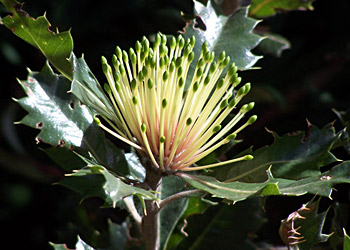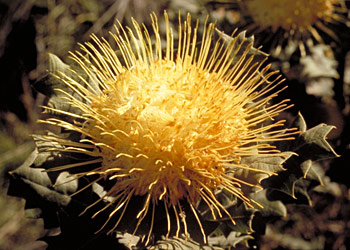
You don't have to call Dryandra Banksia
Alex George
In 2007 Austin Mast and Kevin Thiele published a paper combining the genus Dryandra with Banksia, with a further paper in 2008 covering names that they missed in the 2007 paper. The Western Australian Herbarium has now renamed its specimens of Dryandra, the Australian herbaria have adopted the change for their national plant census, and Kevin Thiele has been 'marketing' the change to the community. For example, an article on the Department of Environment and Conservation's website, repeated in the Department's newsletter Western Wildlife 12 (3): 6-7 (2008), seeks to explain this change to a wider audience.
I wish to point out that there is no obligation to follow the change simply because it is the latest word, or because herbaria have adopted it. Under the International Code of Botanical Nomenclature, scientific names of plants are available for use if they meet certain criteria, and no further direction is given on how to choose which binomial to use, if a plant has more than one available name. In this case, the names of all species of Dryandra meet the criteria, and the user can choose whichever generic name they prefer. Likewise, the Australian Plant Census, co-ordinated by the major Australian herbaria, has no formal status that requires it to be followed. The statement in the web article that a name in Dryandra is 'not current' refers only to the usage as practiced by the Western Australian Herbarium.
 |
|
A 'typical' banksia
Banksia spinulosa
Photo: Brian Walters |
|
The methodology used by Mast and Thiele to justify the change is an analysis of a selected portion of the plants' DNA (genetic makeup), together with a cladistic analysis of the data. Although cladistics is sometimes claimed to be objective it involves human intervention in its interpretation. Different researchers will have differing views on which of the resultant cladograms offered by the cladistic package to publish. Cladistics and DNA analysis are also promoted as a repeatable (and thus reliable) method, but this is possible only if exactly the same material (i.e. the actual samples from which the genetic data were obtained and the data used in a study) are available to other researchers. Material from other plants of the same species may give different results and so we rely on genebanks of a single or few individual plants as representatives of entire taxa. The study of morphology - structure - is just as repeatable, and we can look at the same specimens that previous botanists-such as Robert Brown and George Bentham in the 19th century-looked at.
In their presentations, Mast and Thiele use two cladistic 'trees' to explain their results. One shows Banksia and Dryandra arising (evolving) from the same point (their Figure 1) and is said by them to be the traditional view. The other shows Dryandra arising from within Banksia (their Figure 2), and is said to be a new result, giving a new understanding, that justifies having to place Dryandra in Banksia. In fact, the latter 'tree', not the first, is the traditional view of the relationship of Dryandra and Banksia. It confirms the view that systematic botanists have held since Robert Brown published the name of the genus Dryandra in 1810-to place the genus at the pinnacle of an assumed developmental or evolutionary line within Australian Proteaceae with the implication that it probably evolved out of Banksia and is the most highly advanced genus. In other words, contrary to their claim, Mast and Thiele's 'new' tree confirms the traditional view. (Ed. See Figures 1 and 2 in Why dryandras have changed their name)
The DNA analysis presented shows that Dryandra is a monophyletic taxon, that is, the species 'belong together' genetically. It also shows a number of similar groupings within 'proper' Banksia, the number variable according to the different kinds of DNA analysed. The question then is: what taxonomic rank should be given to these groupings, and how may they be distinguished?
 |
|
 |
Banksia ilicifolia (left), one of three only Banksia species with 'Dryandra-like' inflorescences
Dryandra longifolia subsp. archeos (right)
Photos: Jim Barrow and Margaret Pieroni |
To say that having some species of Banksia more closely related to Dryandra than to other banksias is a 'serious anomaly' and therefore they should all be one genus is nonsense - it's obvious that, when a new organism evolves from a member of a large group, it is going to be more closely related to that member than the others.
Mast and Thiele themselves acknowledged that their results are preliminary, stating in their paper of 2007 that their new classification 'is the least disruptive option at present' (my italic). In particular they foreshadowed further research into Dryandra.
In fact, far from taking the least disruptive option they have taken the most disruptive line with this wholesale transfer, which is an 'easy way out'. The least disruptive option would have been to maintain the two genera. Instead, they have changed the names of 100 species (and the subspecies and varieties) and in the process confused, upset and inconvenienced many people including the public, scientists and the nursery trade, and all their associated databases and day-to-day activities that involve using the names of these plants. Splitting Banksia into several genera would have been less disruptive than combining the genera but would have required far more research than Mast and Thiele were prepared to do in order to find characters that separate those genera consistently. Far better to have done this further research, however, to determine the morphological boundaries of the groups that appear in the cladogram and THEN decide what nomenclatural changes might be required. Even a re-evaluation of their data, addressing the errors and inconsistencies that they contain regarding features such as inflorescence, follicles and cotyledons, would likely provide a different result. My prediction is that further research will either confirm that we recognise the two genera, or will result in Dryandra being resurrected and Banksia being split into several genera (as the DNA already indicates). Either way, further disruption to everyone will result. In other words, it was too soon to make such a sweeping change as combining the two genera.
 |
|
Dryandra praemorsa
Photo: Brian Walters |
|
Mast and Thiele claim that combining the genera gives us a 'new understanding' of their relationships and explains the occurrence of Dryandra in south-western Australia. You don't have to call them all Banksia to do that. In fact, their new classification obscures relationships within Dryandra because they have placed all 100 species in a single series (infrageneric group) within Banksia, equivalent to, for example, just Banksia series Tetragonae with three species and Banksia series Grandes with two. With three subgenera and 24 series Dryandra is at least as diverse as Banksia and this should be reflected in its classification even if it is called Banksia. In Mast and Thiele's classification all this information is lost. And it has been said many times that many groups of plants and animals have evolved in south-western Australia since the Nullarbor Plain and deserts formed-we don't need a molecular analysis to explain that. The lack of any new morphological study of Dryandra in their work means that no advance whatsoever has been made in our knowledge at the level of species and below.
DNA analysis and cladistics are useful tools but should not be followed blindly. Indeed, biologists around the world are increasingly critical of taxonomic results that are dominated by molecular data. DNA is but one component of a biological organism whose physical form we see, but we do not know how DNA translates into that form. There may well be factors that come into play that influence how the same or similar DNA is expressed outwardly, and to varying degrees. I repeat that Mast and Thiele's analysis has simply confirmed that previous botanists, far from being 'tricked' into a 'false understanding' as these authors claim, were on the right track.
I believe that taxonomy should be practical, usable by informed but not necessarily expert users, i.e. it should be based upon readily observable morphological characters. Having studied all species of Banksia and Dryandra I am satisfied that there are perfectly 'good' characters that distinguish Dryandra from Banksia and I shall continue to recognise the two genera. Let us accept the new information that confirms their relationship and continue to call them so. No-one can say we are wrong.
Further reading
George, A.S. (1999), Banksia (Proteaceae), Flora of Australia 17B: 175-251, 376-382, 397, ABRS, Canberra/CSIRO, Melbourne.
George, A.S. (1999) Dryandra (Proteaceae), Flora of Australia 17B: 251-363, 382-391, 397, ABRS, Canberra/CSIRO, Melbourne.
Mast, A.R. (1998), Molecular systematics of subtribe Banksiinae (Banksia and Dryandra, Proteaceae) based on cpDNA and nrDNA sequence data: implications for taxonomy and biogrography, Australian Systematic Botany 11: 321-342.
Mast, A.R. & Givnish, T.J. (2002), Historical biogeography and the origin of stomatal distributions in Banksia and Dryandra (Proteaceae) based on their cpDNA phylogeny, American Journal of Botany 89: 1311-1323.
Mast, A.R., Jones, E.H. & Havery, S.P. (2005), An assessment of old and new DNA sequence evidence for the paraphyly of Banksia with respect to Dryandra (Proteaceae), Australian Systematic Botany 18: 75-88.
Mast, A.R. & Thiele, K. (2007), The transfer of Dryandra R.Br. to Banksia L.f. (Proteaceae), Australian Systematic Botany 20: 63-71.
Thiele, K.R., Why dryandras have changed their name, accessed 16 June 2008
Thiele, K. (2008), Dryandras are banksias!, Western Wildlife 12 (3): 6-7.
Thiele, K.R. & Ladiges, P.Y. (1996), A cladistic analysis of Banksia L.f. (Proteaceae), Australian Systematic Botany 9: 661-733.
From 'Brigge', the newsletter of the Friends of Burrendong Arboretum Inc., July 2005.
Australian Plants online - 2008
Association of Societies for Growing Australian Plants
|